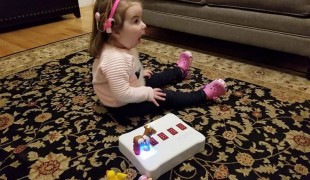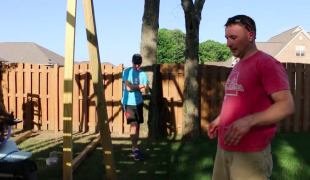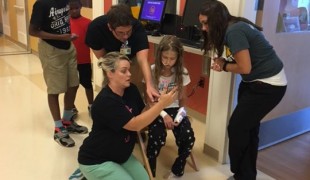- 3136
- 285
- 7
- 9
- 0
- Help Ukraine
About the solution
Kirstie’s daughter, Esme, had a life-limiting neurological condition called Pontocerebellar Hypoplasia (PCH). PCH is a rare disorder that is estimated to affect fewer than 1 in 100.000 individuals worldwide. It primarily affects the cerebellum and the pons, which are responsible for coordination, movement, and basic functions like breathing. However, some forms of PCH can also affect other areas of the brain, including the visual system. Due to this condition Esme suffered from Cerebral Visual Impairment (CVI), which is a form of visual impairment caused by damage or abnormal development of the parts of the brain responsible for the vision. Her eyes worked, her brain was the one impairing her visual ability.
Kirstie wanted to build a space at home where Esme could feel protected and away from background noises. She thought about building a sensory den, as it is a solution that brings several benefits for people with sensory processing difficulties. Nevertheless, the cost of creating an at-home sensory den for a child can quickly mount up. Kirstie had a limited budget, so she had to use imagination and creative power to limit expenses to 300£.
It only took 4 hours for Kirstie to build the sensory den, providing a safe and supportive environment for Esme’s sensory exploration and regulation. Kirstie explained how she created it and what products she used to make it on her own budget:
- Foam mats from IKEA (£22 each)
- Mirrors from IKEA (£4 each)
- Mood Tubes from Learning Space (Between £70 and £120)
- Bubble Tube (from ASDA, ARGOS or The Range)
- UV Lamp from Amazon that comes with UV Crayons (£50)
- UV Strips from Amazon (£12 for 12 pieces)
- UV stars and moons from Learning Space (£4,99 and £6,99 respectively)
- UV toys from Louise’s Sensory Boxes
The main consideration she had when creating the room was for it not to be too busy, as that would be a sensory overload. Also, the room needed to be completely neat and organized. Another contemplation Kirstie had was to create extra light so that Esme could see and feel some of it, for example by placing the bubble tube on top of the mood light. She also created a “cozy corner” where she placed a large, roll-up fluffy sleeping bag. As Kirstie said “A den like this can be achieved for next to nothing. Products especially for visually impaired children can be 10 times the normal price, but you can find lots of items that are suitable for a sensory room from high-street stores, such as Home Bargains, B&M and Argos”.
Sadly Esme passed away when she was four years old, in February of 2021, due to PCH. When she was born her parents were told she would live up to two years.
Adapted from:
https://www.birminghammail.co.uk/whats-on/shopping/mum-builds-incredible...
https://www.nei.nih.gov/learn-about-eye-health/eye-conditions-and-diseas...
This solution shall not include mention to the use of drugs, chemicals or biologicals (including food); invasive devices; offensive, commercial or inherently dangerous content. This solution was not medically validated. Proceed with caution! If you have any doubts, please consult with a health professional.
DISCLAIMER: This story was written by someone who is not the author of the solution, therefore please be advised that, although it was written with the utmost respect for the innovation and the innovator, there can be some incorrect statements. If you find any errors please contact the patient Innovation team via info@patient-innovation.com
-
-
479
-
0
-
5804

Father invents toy to help his daughter learn Braille
CAREGIVING
Playing
Usher Syndrome
Congenital Deafness
Visual Impairment
Educational/Leisure device (book, toy, game...)
Strategy/Tip
Vision problems
Loss of balance
Hearing loss or ringing in the ears (tinnitus)
Caregiving Support
Medical Genetics
Neurology
Ophthalmology
Otorhinolaryngology
Pediatrics
United States
-
-
-
586
-
1
-
12248

Swing for wheelchair users
CAREGIVING
MOVING IN A WHEELCHAIR: Moving using a wheelchair.
Playing
Muscular Dystrophy
Neuromuscular Disorders
Cervical spinal cord injury/Tetraplegia
Walking Aid (wheelchair/walker/crutches)
Strategy/Tip
Difficulty coordinating movements
Paralysis of the legs and lower body
Muscle weakness
Caregiving Support
Medical Genetics
Neurology
Pediatrics
United States
-
-
-
591
-
0
-
8840

Pokemon Go is helping sick children interact
CAREGIVING
Video gaming
Brain Cancer
Brain Injury (Abscess, Brain Barrier Defect, Brain Contusion, Brain Hemorrhage, Brain Edema)
Leukaemia
Neuromuscular Disorders
Educational/Leisure device (book, toy, game...)
Strategy/Tip
Gait abnormalities (e.g., walking difficulties, unsteady gait)
Muscle cramps or spasms
Stiffness or rigidity (difficulty moving)
Paralysis of the legs and lower body
Muscle weakness
Confusion
Anxiety
Headaches
Fatigue
Managing pain
Enhancing Mental Health
To improve Treatment/Therapy
Caregiving Support
General and Family Medicine
Medical Genetics
Neurology
Pediatrics
Public Health
United States
-
 en
en